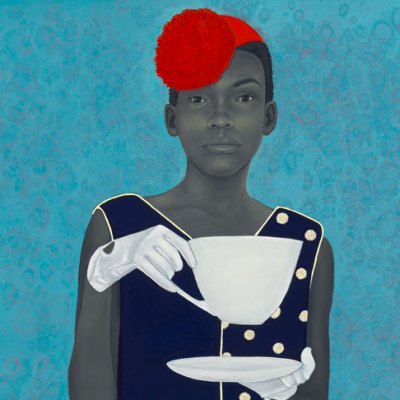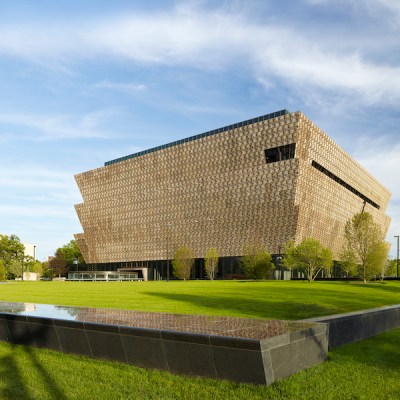At a retreat a few years ago, curators from the Hirshhorn Museum and Sculpture Garden in Washington, D.C. held a brainstorming session to contemplate the museum’s most successful shows in recent memory. As director Melissa Chiu revealed, an exhibition’s success depended largely on whether it worked with or against the unique architecture of the Hirshhorn.
The building, designed by Gordon Bunshaft and opened to the public in 1974 as part of the Smithsonian’s constellation of museums on the US National Mall, was intended to serve as ‘a large piece of functional sculpture’, and its cylindrical walls, hollow centre, and curved galleries have at times fought with the artworks on display. Curators realised that the most effective exhibitions – Andy Warhol’s Shadows, for instance, in which 102 silkscreened and hand-painted canvasses extended around 450 linear feet of the museum’s curved walls – have embraced the space’s circularity. This insight led curators to begin dreaming of a commission for the museum’s third floor, a dream that culminated in the recent opening of Mark Bradford’s Pickett’s Charge, on display from November 2017 to November 2018.
Installation view of ‘Mark Bradford: Pickett’s Charge’ at the Hirshhorn Museum and Sculpture Garden, 2017 Photo: Cathy Carver; courtesy of the artist and Hauser & Wirth

The massive piece, which is comprised of eight paintings totalling 400 linear feet that completely encircle the building’s interior, is a striking example of the synchronies that can emerge when artist, subject matter, and gallery space work together. Bradford, fresh from representing the US at the Venice Biennale, in which he piled trash outside the neoclassical national pavilion to represent a democracy in ruins, seemed an artist who would fit with the Hirshhorn’s stated mission to ‘provide a national platform for the art and artists of our time.’
Yet the artist admitted to being stymied, at least at first, by the task of finding a fitting subject for the commission. With a history of engaging with topics of contemporary importance such as the early AIDS epidemic (Finding Barry), Hurricane Katrina (Mithra), and police shootings of African Americans (150 Portrait Tone), Bradford initially developed the piece as a way to contend with the National Mall’s history of civil-rights protest. When this subject proved a non-starter, he returned to the building’s cylindrical shape to create a work that would reconsider a now-extinct form of entertainment media: the cyclorama.
Specifically, Bradford drew inspiration from Paul Philippoteaux’s cyclorama The Battle of Gettysburg (1883), an enormous, 360-degree depiction of Pickett’s Charge which toured the US, offering 19th-century viewers an immersive experience of the US Civil War’s decisive moment. In the decades after the war’s end, Pickett’s Charge came to represent a moment of possibility dashed for believers in the Lost Cause, the closest the Confederacy (a would-be nation with the protection of slavery enshrined in its founding documents) came to victory. The Battle of Gettysburg depicts this moment as a heroic show of hypermasculine bravery, and contains no reference to the white supremacy underwriting the Southern cause.
Bradford’s modern collage-paper cyclorama distorts and amplifies Philippoteaux’s original. To begin the piece, the artist down-loaded a copy of The Battle of Gettysburg off the internet and had it blown up and printed on to durable blueback paper. The eerie, pixelated images of soldiers and horses from Philippoteaux’s original emerge and recede from Bradford’s work, frustrating any attempt to forge narratives between panels. Bradford adds to these distorted echoes of the original cyclorama his own mix of materials from lived use, building up layers of paper and rope, then ‘dynamiting’ the surface by yanking o the rope. In addition to puncturing any notion of linear history, this process foregrounds the struggle between artist and work, creation and destruction. ‘What’s left [on the surface] is an echo of the battle,’ Bradford says.
The metaphor is apt. What ultimately emerges from Bradford’s painting is a raw sense, made all the more poignant given the current US political climate, that history is never as tidy as some would depict it to be – that America must confront the myths it tells about its past if it ever wants to move forward. It is perhaps ironic, then, that the success of Pickett’s Charge rests on its lack of struggle with its surroundings. Usually architecture flattens or the gallery formalises the work, but in this case, Bradford says, the curved walls, the flooring, and even the doorways breaking up panels each supplemented his vision. ‘The Hirshhorn,’ Bradford comments, ‘finished [the painting] for me.’ This harmonious meeting of building, subject matter, and artist is what allows the viewer to become unsettlingly immersed in the work’s abstracted sense of history frayed at the ends – of the battle within and without.
‘Mark Bradford: Pickett’s Charge’ is at the Hirshhorn Museum and Sculpture Garden, Washington, D.C. until 12 November 2018.
From the January issue of Apollo. Preview and subscribe here.

